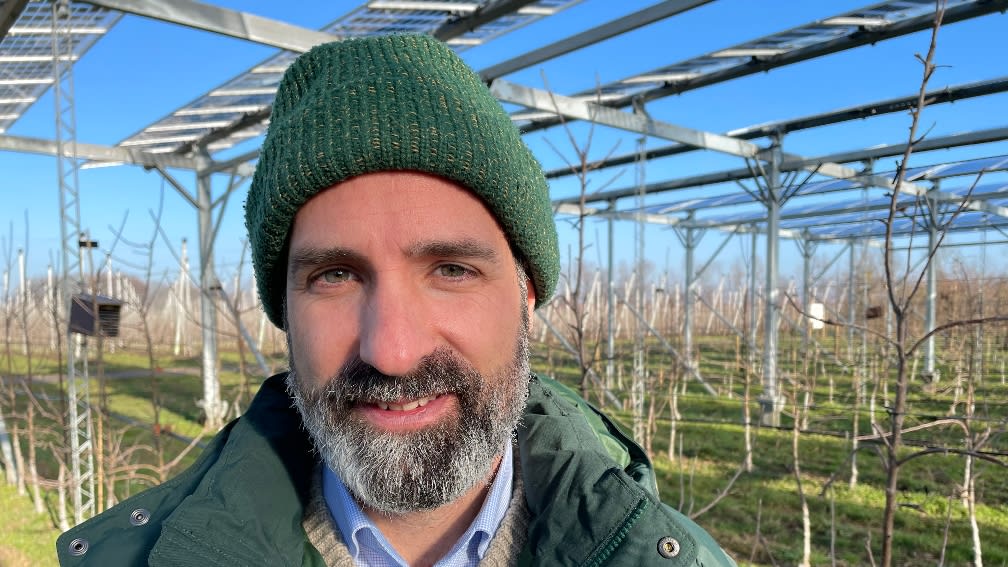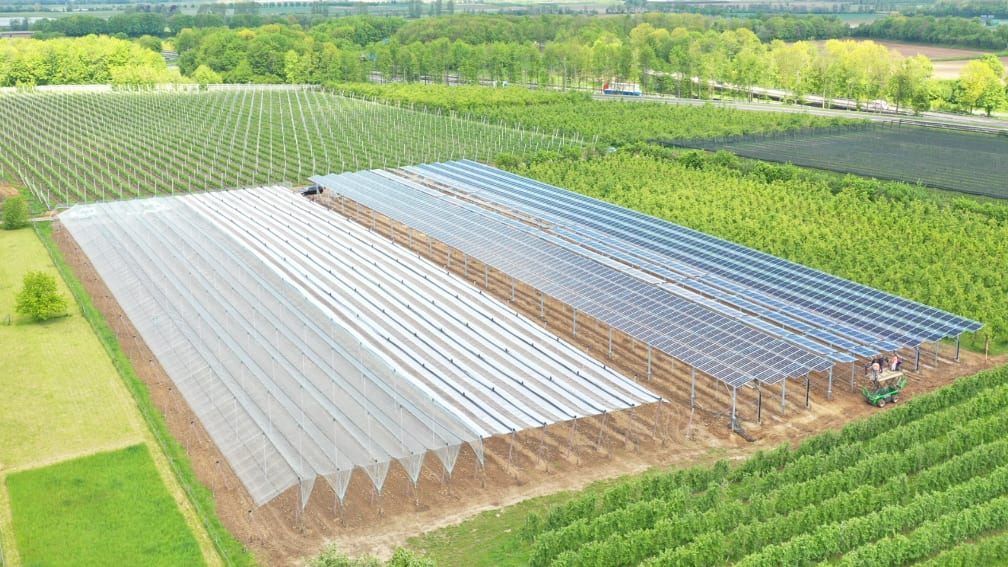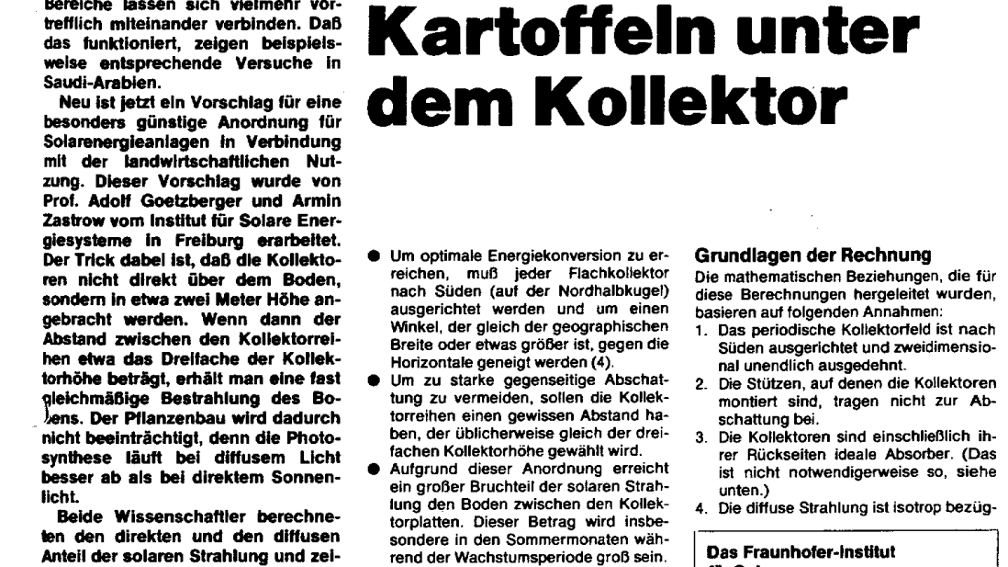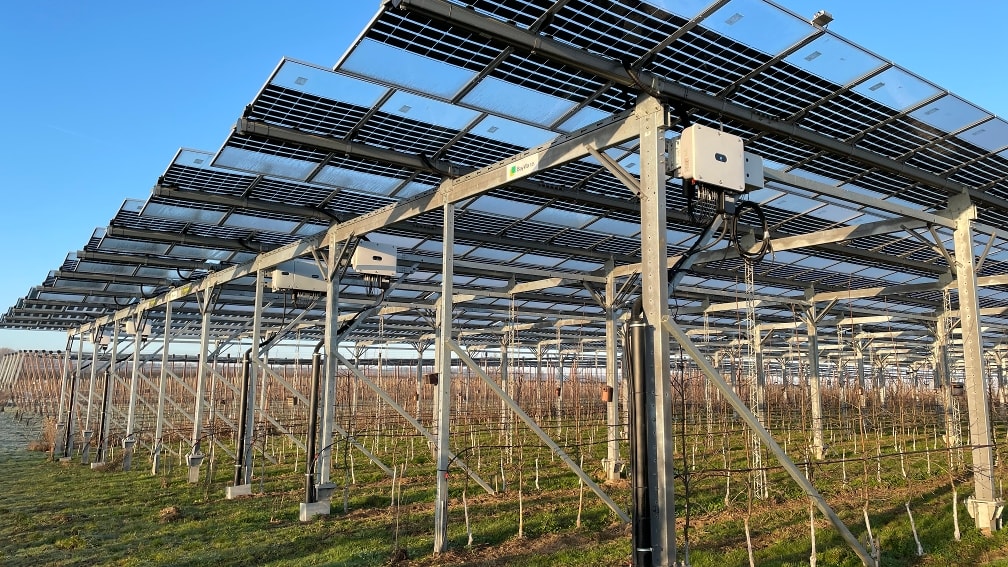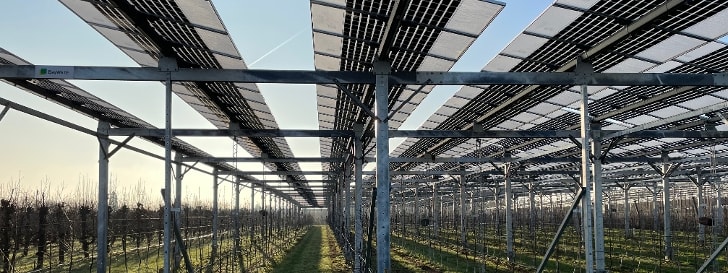
Potatoes Below, Photovoltaics Above
How Farmers Harvest Fruit and Electricity at the Same Time
In the past, solar power was mainly generated on roofs and designated fields. But now, agricultural production and energy generation can also be combined. Stephan Schindele, Head of Agri-PV Product Management at BayWa r.e., reveals what this looks like and what possibilities agrivoltaics, or Agri-PV systems, offer.Mr Schindele, we are standing in front of an apple orchard in Gelsdorf near Bonn. We see young apple trees in a row and solar modules a good 4 metres above them.
This is a so-called fruitvoltaic system, a special application of agrivoltaics. The solar modules above the apples are translucent, so in future the farmer will be able to harvest fruit and electricity in the same field.
What does translucent mean?
Half of the PV module surface is transparent so that enough light reaches the trees. The other half hits solar cells and generates electricity.
How do the fruits cope with the lower amount of light?
We are still collecting information for the apples here, but so far we don't see any disadvantages. In one of our tests on a raspberry crop in the Netherlands, the berries received an average of 60% of the possible light. And yet we registered only very slight reductions in yield. The quality of the fruit did not suffer either.
The grower should save water through shading.
Yes, because of the shading, less moisture evaporates in the soil and plants, so the farm needs up to 40 percent less water. In addition, investments in crop protection, for example in hail protection nets, can be reduced because the modules help against rain or hail.
Why are you testing in the Netherlands?
The country is densely populated and the government wants to use the available land in a multifunctional way. We see this desire in many countries around the world and more and more in Germany.
But do we have to use agricultural land when Germany still has so many roofs without photovoltaics?
The German government wants to provide 80% of the country's electricity from renewable sources by the end of the decade. We are currently at a good 40%. Half of the PV expansion is to take place on roofs and the other half on agricultural land. If we were to install only on roofs, the costs would be higher, the expansion would not be fast enough and the craft industry would reach their limits. That is why we have to go to agricultural land. The 4% of arable land that farmers in the EU will have to set aside in the future for more biodiversity, for example, would already be ideal for biodiversity PV.
What is biodiversity PV?
In projects in America, we specifically include beekeepers and their bee colonies in the planning of Agri-PV systems: Meadows with native herbs and flowers, on which the bees live, are created under the PV modules. As a side effect, the animals pollinate the surrounding fields.
But in any case, you have to let light on the ground - and lose area for electricity generation.That's how it is. Classic photovoltaic systems use the entire surface area. BayWa r.e. is committed to allowing vegetation between the PV modules. Because it is good for biodiversity and the groundwater balance, among other things.
But this reduces the energy yield and makes the system more expensive on average, doesn't it?
Right, but Agri-PV provides additional benefits that have not been fully appreciated so far. So far, we have considered the electricity yield and the benefits from water savings, crop protection or more biodiversity separately. But a farmer can see the benefits on his farm across all areas: By shading with our PV modules, he keeps more water in the soil. He can protect against weather extremes, help protect species and generate electricity at the same time. I think governments should also pay more attention to this comprehensive benefit.
You yourself worked at the Fraunhofer Institute for Solar Energy Systems ISE in Freiburg, where you helped drive the development of Agri-PV before joining BayWa r.e.. The idea of Agri-PV originated at Fraunhofer ISE, right?
Yes, the physicist Adolf Goetzberger founded the Fraunhofer Institute for Solar Energy Systems ISE in Freiburg in 1981 and published the idea of double harvesting. Together with Armin Zastrow, he wrote a text entitled "Potatoes under the collector" back in 1981. Goetzberger foresaw that solar energy would one day be the cheapest form of energy production. However, he also foresaw land use competition and predicted the dual use of agricultural land. Goetzberger died on 24 February 2023 at the age of 94. His idea of harmony between agriculture and PV will resonate for a long time to come.
Why did it take almost 40 years to implement Adolf Goetzberger's vision?
The time was not yet ripe back then. Today we are exactly at the point where dual use is starting to make sense. The costs for PV systems have dropped and PV can be integrated into more and more surfaces - for example, on car parks, in floating solar systems on industrially used waters or even as part of agricultural processes.
What effect does the installation of an Agri-PV system have on existing premiums that farmers receive for the land in question?
A certain amount of land is lost due to the racks; legislators assume a maximum of 15%. Anyone who builds in accordance with a defined Agri-PV standard therefore receives 85% of the basic premium or the basic income support, as it has been called since 2023, for the area built over.
And how is the solar electricity generated currently subsidised?
According to the "Renewable Energy Sources Act 2023", all photovoltaic systems receive the same subsidy. Highly elevated systems receive a technology bonus of 1.2 cents per kilowatt hour. However, here in Gelsdorf, for example, we would need 3.5 cents bonus to operate the plant economically for the farmer and for us as project developers. Therefore, instead of price regulation, we recommend volume regulation, i.e. a pot from which, for example, 200 megawatts of high-mounted Agri-PV are subsidised annually at an economic price. If the volume is exhausted by the market and the policy is a success, the volume can be increased gradually.
The plant we are looking at is therefore not yet profitable, right?
Here in Gelsdorf we are testing and comparing the fruit crop protection offered by solar modules with that of hail protection nets and protective films. In the area of permanent grassland and arable farming, however, we can already implement Agri-PV very cost-effectively and profitably from a certain number of hectares with the new subsidy. Of particular interest are permanent grassland areas, on which we can develop various scenarios.
What scenarios can arise?
In France, we are planning to implement cowvoltaics projects: Cows graze under the PV modules and find shade in summer. The grassland under the system can also be used for cutting hay. In another project in France, bonsai oaks are to be cultivated on 100 hectares between the PV module rows. The trees are regularly pruned, but their roots spread into the ground and provide the basis for truffle cultivation in the partial shade between oaks and solar modules.
Agri-PV systems, unlike ground-mounted systems, are therefore rarely standard systems.
That's right, we are always dealing with the needs on site. If the energy transition is to work, we must learn to think and act in a multidisciplinary way. The key to a successful energy transition lies in agriculture, because it offers the greatest land potential.
What still needs to happen for this potential to unfold properly?
In order for the potential to unfold and for farmers to benefit from the energy transition, we urgently need to speed up building permit procedures. Too much bureaucracy and over-control is inefficient and not commensurate with the urgency of climate protection. We need bold political action and the local implementation of renewable energy projects – be it our own roofs, on our car parks or even at the farmer's house next door.
Turn to BayWa r.e. to find out how you can get more out of your farmland with an agri-PV system and produce food and sustainable energy at the same time.
